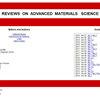Mechanical testing and engineering applicability analysis of SAP concrete used in buffer layer design for tunnels in active fault zones
IF 3.6
4区 材料科学
Q2 MATERIALS SCIENCE, MULTIDISCIPLINARY
引用次数: 0
Abstract
To tackle the challenge of dislocation damage when tunnels traverse active fault zones, this study introduces the concept of using brittle buffer materials for anti-dislocation. Building on this concept, we propose a novel concrete buffer material utilizing large-sized spherical super absorbent polymers (SAP) as a porogen, aimed at ensuring the safety of tunnel structures during active fault dislocations. To investigate the feasibility and superiority of SAP concrete as a buffer material compared to other similar materials, we prepared samples with three different SAP concrete proportions and conducted a series of physical and mechanical tests. The results show that SAP pre-hydrated with 0.2 mol·L活动断层带隧道缓冲层设计中使用的 SAP 混凝土的力学测试和工程适用性分析
为了应对隧道穿越活动断层带时发生错位破坏的挑战,本研究提出了使用脆性缓冲材料抗错位的概念。在这一概念的基础上,我们提出了一种新型混凝土缓冲材料,利用大尺寸球形超吸收聚合物(SAP)作为致孔剂,旨在确保隧道结构在活动断层错位时的安全。为了研究 SAP 混凝土作为缓冲材料的可行性以及与其他类似材料相比的优越性,我们制备了三种不同比例的 SAP 混凝土样品,并进行了一系列物理和力学测试。结果表明,用 0.2 mol-L-1 碳酸钠溶液预水化的 SAP 在水泥浆中的水分流失速度较慢,有助于混凝土的水化反应。SAP 混凝土的渗透系数约为 10-7 cm-s-1,略低于相同密度水平的泡沫混凝土。SAP 混凝土缓冲材料具有明显的脆性,与泡沫混凝土和橡胶混凝土等其他缓冲材料的韧性形成鲜明对比。利用 SAP 混凝土材料的脆性,当应用于受粘滑活动断层错位影响的隧道时,其瞬间失去的抗压能力可提供出色的屈服性能,从而保护隧道衬砌免受损坏。然而,在某些圆周压力条件下,SAP 混凝土的峰值强度和残余强度都会显著增加。高峰值强度和残余强度不利于 SAP 混凝土发挥有效的缓冲作用;因此,有人提出了一种间歇布置预制缓冲块的应用方法。
本文章由计算机程序翻译,如有差异,请以英文原文为准。
求助全文
约1分钟内获得全文
求助全文
来源期刊

Reviews on Advanced Materials Science
工程技术-材料科学:综合
CiteScore
5.10
自引率
11.10%
发文量
43
审稿时长
3.5 months
期刊介绍:
Reviews on Advanced Materials Science is a fully peer-reviewed, open access, electronic journal that publishes significant, original and relevant works in the area of theoretical and experimental studies of advanced materials. The journal provides the readers with free, instant, and permanent access to all content worldwide; and the authors with extensive promotion of published articles, long-time preservation, language-correction services, no space constraints and immediate publication.
Reviews on Advanced Materials Science is listed inter alia by Clarivate Analytics (formerly Thomson Reuters) - Current Contents/Physical, Chemical, and Earth Sciences (CC/PC&ES), JCR and SCIE. Our standard policy requires each paper to be reviewed by at least two Referees and the peer-review process is single-blind.
 求助内容:
求助内容: 应助结果提醒方式:
应助结果提醒方式:


